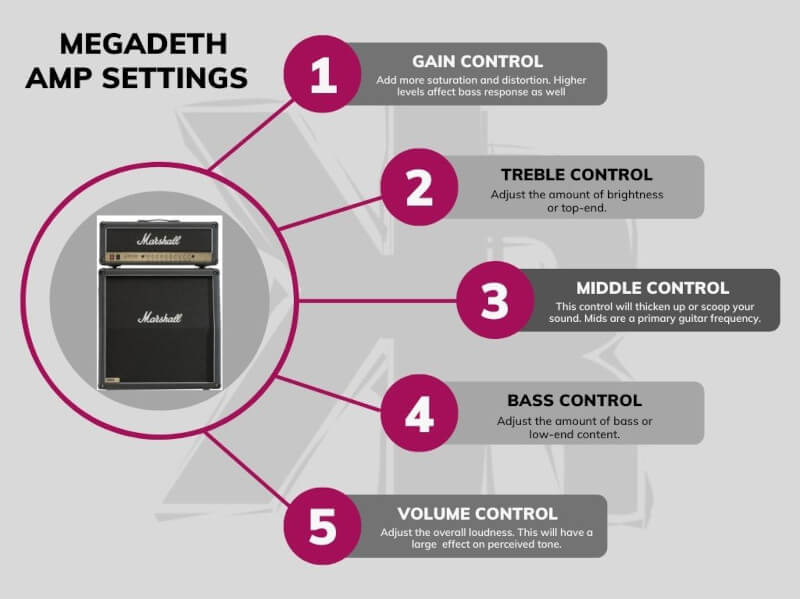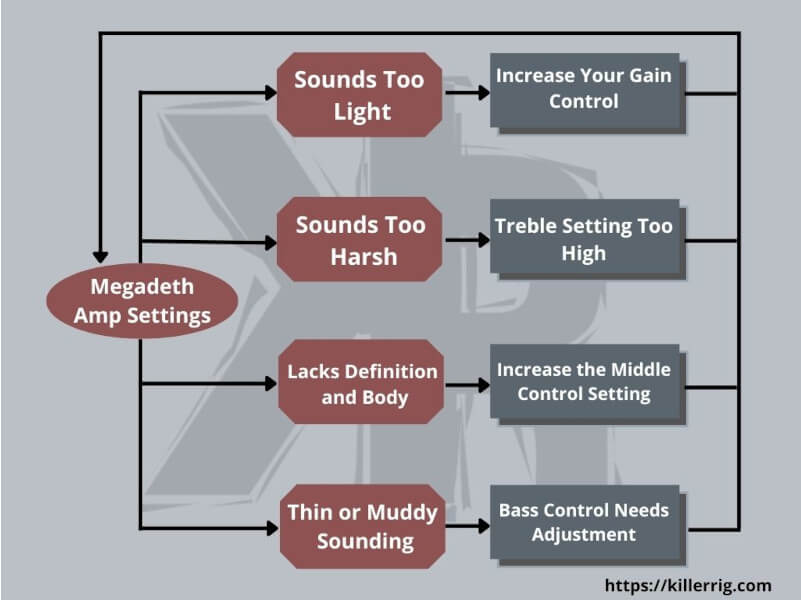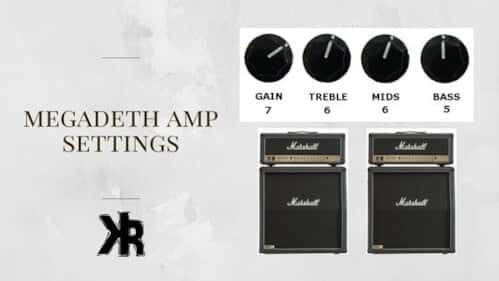Table of Contents
Megadeth is a very popular metal band! They have a history that involves some of today’s most famous artists. Dave Mustaine has taken the group to become one of the big 4 metal bands in the world! Alongside others like Metallica and Anthrax.
To get a sound like this, you will need the right amp settings. But also the proper gear. This tone is sculpted with years of experimentation! It will require some experimentation to again recreate for yourself.
This Killer Rig guide will help get you started with some gear recommendations. But also the optimal Megadeth amp settings!
What is the Megadeth Sound?
The Megadeth sound is a unique blend of metal styles. Some that have been heavily influenced by classical music and NWOBHM.
The band often uses odd time signatures. This makes their music complex and challenging to play. Add in their use of techniques like palm muting and pick scraping. And their songs have a unique and signature sound.
In terms of tone, Megadeth’s guitars are typically very high gain with lots of distortion. The sound is thick, yet still articulate, and often uses some reverb to create a sense of space.
Some quick Megadeth amp settings are:
- Gain: 7.
- Treble: 7.
- Mids: 5.
- Bass: 6.
- Presence: 6.
To get this tone, you’ll need an amp that can provide lots of distortion without sounding muddy.
Check out our Metallica amp settings here!
Gear Needed For The Megadeth Sound
The gear needed for the Megadeth tone is pretty simple and easy to get.
- Marshall amplifiers are Dave Mustaine’s go-to for the tones he gets. The one we would recommend would be the Marshall JVM410. But the Code 50 would also do well here and is more affordable.
- An electric guitar with high output pickups. One designed with a thicker mid-range, would be ideal for this sound. Dave is known to play Dean guitars but has also used Jackson and the Gibson Flying V.
- Some amplifiers can get close to the level of distortion needed. But a boost might also help to shape things up. If you have an amp that is a bit too bass-heavy, a good boost pedal can help tighten things up as well.
- Adding a bit of reverb can help add some space, most amps will have this built-in. You might also consider a chorus or phaser pedal as well.
Megadeth Amp Settings
Settings up the amplifiers is just as important as owning them. Without the right settings, you won’t get the tone you need. But first, it’s best to learn about the controls and what they do.

Gain Control
The gain control will alter the signal and provide more distortion. As you turn up the control, the more distorted the tone will become. For a good Megadeth tone, you will want a higher level of distortion from your amp, but nor overbearing.
One thing to consider is that as the gain setting increases, so will the level of bass and thickness. Certain amplifiers will become very muddy with higher levels of gain. This can cause a loss of articulation and a woofy sound.
Sometimes a balance of bass and gain will be required, so don’t just crank the control and expect a great metal tone. You may have to experiment with your amplifier to find the right setting.
Check out our Slayer amp settings here!
Equalizer Controls
The next controls to consider are the equalizers or treble, mids, and bass. These settings are crucial for the right articulation and bite in your sound.
- The treble control is important! This is because it will add the articulation and bite you need for the right Megadeth sound. But use caution, as the sound can become harsh with higher settings. Especially with an amplifier like a Marshall.
- Next is the mid-control. This knob will add thickness and body to your sound. Dave Mustaine did not scoop his sound, and so set this control at 5 to get started and adjust to taste.
- The bass control is very important, as too much can create a muddy tone. But too little will remove your depth. For a good Megadeth sound, you will want a punchy bass response. But just remember that the gain control setting will affect your low end as well.
Some amplifiers will also come with presence or depth controls. These controls alter how the power section of your amplifier will respond. Set these controls to 5 when getting started and use them to enhance your EQ.
Popular Megadeth Songs and Their Amp Settings
Once you have a good grasp of how the amp settings work and what they do, it’s time to play along with some Megadeth songs. Adjust your settings as you play to get as close as possible. We will also provide a few suggestions for each song.
More big four: Anthrax amp settings.
Symphony Of Destruction
With the right guitar and amp, this song is the Megadeth tone and can easily be dialed in with these settings:
- Gain: 7.
- Treble: 7.
- Mids: 5.
- Bass: 6.
- Presence: 5.
While the sound is distorted, the gain is not overbearing. A setting of around 7 on a Marshall amplifier should be in the neighborhood. Don’t crank the gain too high or the sound may become muddy.
You can then add a bit more bass or increase the depth control. Doing so will add a bit more punch and get better, tighter palm mutes. The volume control can be adjusted to taste and is not as important.
The key to this song is the balance of gain and bass. Too much of either will ruin the tone.
Try our Bullet for my Valentine amp settings here!
Sweating Bullets
This song has a bit more distortion than Symphony Of Destruction. But the basic settings are similar. Try these:
- Gain: 8.
- Treble: 7.
- Mids: 3.
- Bass: 6.
- Presence: 6.
The biggest difference here is in the mids as the tone is more scooped. By reducing the mids, you will also get a bit more of that Megadeth bite and articulation.
This song also uses a bit more gain than Symphony Of Destruction. So don’t be afraid to turn it up a bit.
Once again, the key is balance. Too much distortion will make the sound muddy. Too little will make it sound thin and lacking in body. This song is already quite bright, so the right bass setting is important.
You might also benefit from a phaser effect pedal, as this song does utilize one in certain parts.
In My Darkest Hour
This song is a bit different from the others as it has a thicker tone. There is a higher mid-setting used to get this sound. For this song, you will want to use these settings:
- Gain: 7-8.
- Treble: 6.
- Mids: 6.
- Bass: 7.
- Presence: 6.
Experimentation with the gain setting is important. You want to get close to saturation while maintaining a tight bass response. Add more body to the sound by increasing your mid-control. This song uses more mids than most Megadeth tunes.
You may also benefit from a bit of chorus to add space and fill out the sound. Reverb will also work, but don’t use it too much.
The lead work will benefit from higher gain settings and more treble to cut through the mix. But if you decide to keep the same rhythm settings, they will sound good.
Rust In Peace Album Amp Settings
Are you looking to get a general idea of the setting used on the Rust in Peace album? Then these settings are a good place to start:
- Gain: 7-8.
- Treble: 6.
- Mids: 7.
- Bass: 7.
- Presence: 6.
The electric guitar tone in the Rust In Peace album is not overly saturated. This means that your gain levels don’t need to be very high. And in Megadeth fashion, the mids are somewhat high as well as the guitar tone sounds thick and has body.
The treble is also not as high as some other songs. While there is still a good amount of articulation and bite, it’s better balanced.
The higher mid-settings will also add more cut. This takes advantage of the guitar’s natural frequencies. This also lends to a better throaty growl from the sound, which is great.
Megadeth Tone Tips
If you have tried all our suggestions but are still struggling to get the right tone, here are a few other tips!
- Maybe your amplifier is just not able to obtain the right level of gain or saturation. Then consider using a distortion pedal. The Boss MT-2 is a great pedal to consider, especially for Megadeth tones.
- If your treble setting is high and harsh, consider turning it down. Then add a bit more bass or mids to thicken the sound. Use small adjustments until you get the right settings.
- The tone control on your guitar can also be used to eliminate harshness. If it is maxed, try turning it down to shape your treble response and warm things up.
- For a tone that is muddy and woofy, try turning down your bass control. You want a more punchy tone, which is not overly thick. Your gain control, when set high, can also add too much of a muddy sound.
- Experiment with different pickup settings. The bridge pickup will be brighter and more focused. As opposed to the neck, which is thick and round sounding.
- Make sure your guitar is also up for the task. Not every guitar is built to play metal, the pickups need to have the right tone and output for this to work.

Conclusion
We hope this article has helped you understand a bit more about Megadeth’s tone and how to achieve it. It may seem daunting at first. But with a bit of patience and experimentation, you should be able to get close to that classic Megadeth sound.
Sometimes it might take trying a few different pieces of gear to get the sound you are looking for. Don’t give up!
FAQs
What amps does Megadeth use?
Megadeth uses Marshall amplifiers like the JVM410 and the JCM800.
What guitars does Megadeth use?
Megadeth has used many guitars over the years. But their current main axes are the Jackson KV2 and the Dean Angel of Death, which is Dave’s signature guitar.
Does Megadeth use pedals?
Megadeth has used a variety of pedals. But currently, Dave uses the Boss MT-2 Metal Zone, his signature Zoom G2.1DM, and a Boss CH-1 Chorus pedal.

